Qijia culture laid foundation for subsequent bronze culture

The bronze axe and copper knife excavated in Gansu Province come from Qijia culture.
Qijia culture, based in Gansu Province, refers to a culture that originated in the late Neolithic Age. At that time, China had already entered into the bronze and stone era. Qijia culture was named after the Qijiaping Site, the location of a major complex of ruins. The Qijiaping Site was found by Johan Gunnar Andersson, a Swedish archaeologist, in 1924.
Qijia culture spanned from 2200 BC to 1600 BC and it was a significant archaeological culture located in the upper reaches of the Yellow River. It was mainly distributed from eastern Gansu Province to Zhangye and Qinghai Lake, ranging from Gansu Province, Ningxia Hui Autonomous Region, Qinghai Province and Inner Mongolia Autonomous Region. With the development of related research, Qijia culture has grown into an important research subject that offers clues about the formation of Chinese civilization and its early development, which exerted great influence at home and abroad.
The pottery industry of Qijia culture was well developed and its people mastered the complicated skills required to use kilns. Copper articles excavated in tombs of Qijia culture archaeological sites reflect the improvement in productivity at that time, which laid the foundations for the later development of bronze culture.
The production of jade articles during the Qijia culture period was well developed. These jade articles played an influential role in connecting the western jade production locations with the eastern jade culture. Relevant studies on the texture of these jade articles demonstrate that people during the Qijia culture period possibly exploited Hetian jade or Kunlun jade.
Although few relics of mining and metallurgy have been found at the sites of Qijia culture, it is still considered one of the earliest bronze cultures because it was rich in bronze artifacts.
